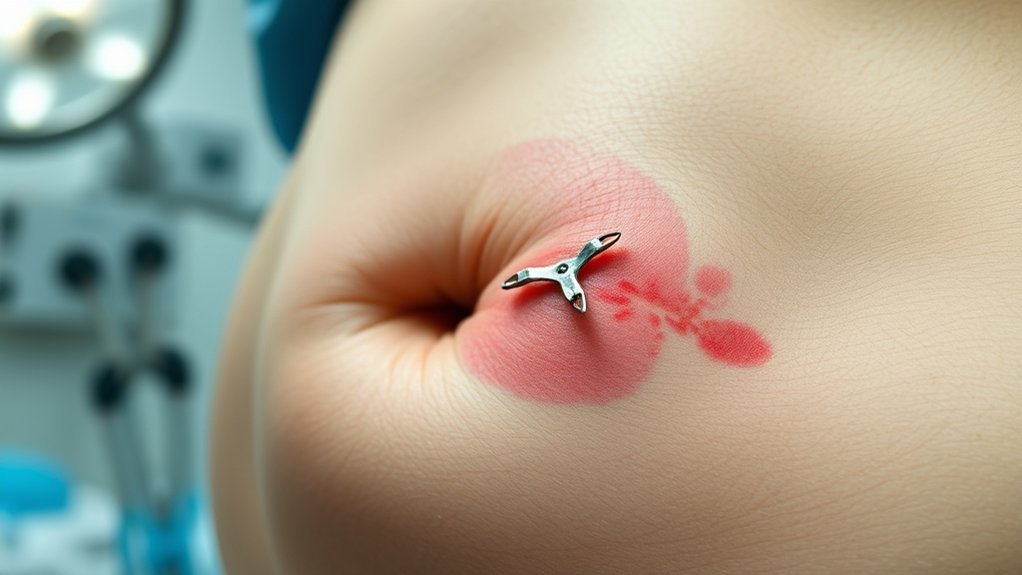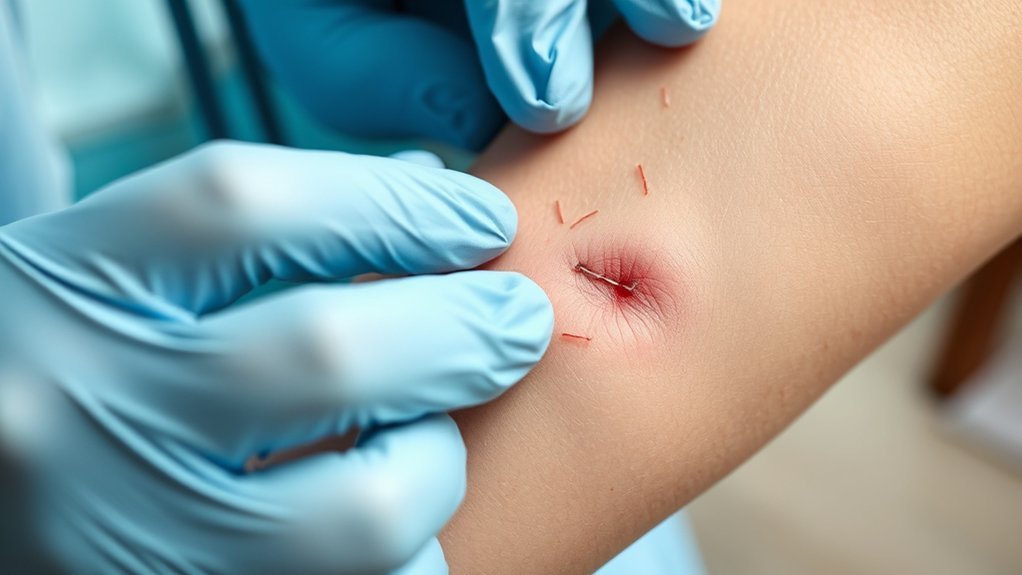Stitch care is essential for preventing complications like infections and wound dehiscence after surgery. Many factors contribute to improper care, including how well you clean the wound and your individual health risks. Understanding these elements can be critical for your recovery. Are you aware of the specific symptoms to watch for or the best practices to guarantee healing? Let’s explore the key aspects of stitch care and what you can do to minimize risks.
Understanding Surgical Wound Dehiscence
Surgical wound dehiscence (SWD) occurs when a surgical incision unexpectedly opens, which can lead to serious complications. Understanding the risk factors is vital for patient safety.
Factors such as vertical incisions, stapled closures, previous caesarean sections, and significant blood loss increase the likelihood of SWD. You should be vigilant for signs of infection, including exaggerated redness, swelling, warmth, increased pain, and discharge from the incision site. These signs can hinder the healing process.
Vertical incisions, stapled closures, and infection signs like redness and swelling can increase the risk of surgical wound dehiscence.
To mitigate risks, implement preventative measures like supporting the wound during movements, avoiding heavy lifting, and closely monitoring healing progress.
Educating yourself about the healing process and potential complications is essential for improving recovery outcomes and ensuring effective post-operative care.
Factors Contributing to Improper Stitch Care
Proper care of stitches is essential to prevent complications like infections and dehiscence following surgery. Several factors contribute to improper stitch care, increasing the risk of surgical site infections.
For instance, inadequate cleaning of the wound before stitching can introduce bacteria, leading to infections. A lack of sanitization during procedures can affect up to 3% of patients, heightening the risk of complications.
Additionally, conditions such as obesity, diabetes, and a weakened immune system make individuals more susceptible to stitch-related issues. Prolonged surgical times, particularly those over two hours, also correlate with increased exposure to contamination.
Finally, failing to adhere to postoperative care instructions—like keeping stitches dry and avoiding touching them—can lead to further complications.
Recognizing Symptoms of Infected Stitches
You should watch for signs of infection around your stitches, such as redness, swelling, and increased pain.
If you notice yellow or green pus, warmth at the site, or a fever, it’s vital to seek medical attention.
Recognizing these symptoms early can help you take immediate action to prevent complications.
Common Infection Symptoms
Recognizing the symptoms of infected stitches is vital for prompt treatment, as early intervention can prevent complications.
Common signs of infection include redness and swelling around the surgical site, indicating inflammation. You might also notice increased pain or tenderness at the wound, which often accompanies an infection.
Warmth around the stitches suggests a localized infection, especially if there’s blood or pus discharge. Additionally, a foul odor from the area, along with yellow or green drainage, serves as a clear indicator that medical attention is needed.
If you experience fever alongside these symptoms, it signals a systemic response to the infection. Addressing these symptoms quickly is essential to guarantee proper healing and avoid further complications.
Risk Factor Identification
Identifying risk factors for infected stitches is essential to preventing complications and ensuring effective healing.
The symptoms of infected stitches can include increased tenderness, redness, and swelling around the site. If you notice yellow or green drainage, pus, or a foul smell, these are strong indicators of a bacterial infection that needs immediate attention.
Pre-existing conditions, such as diabetes, obesity, or a compromised immune system, can increase your vulnerability to infections. Pay close attention to excessive pain or warmth at the stitch site, as these can signify an infection.
Early detection of signs like blood or pus leakage is vital, as untreated infections may lead to severe complications requiring hospitalization. Stay vigilant to promote better healing outcomes.
Immediate Action Steps
Prompt action is required when symptoms of infected stitches arise. Look for signs such as redness or swelling around the stitches, increased pain, and foul-smelling drainage.
Yellow or green pus is a significant indicator that demands immediate medical attention. If you experience fever alongside these symptoms, it’s essential to consult a healthcare professional without delay.
Risk factors like obesity, smoking, diabetes, and a compromised immune system can heighten your susceptibility to infections post-surgery.
Early detection is key; untreated infections can lead to serious complications, including tissue damage or systemic issues like sepsis.
Don’t hesitate to seek help if you notice any signs and symptoms of infected stitches—it’s important for your health.
Risk Factors for Postoperative Wound Infections

While various factors contribute to the risk of postoperative wound infections, patient-related and procedural elements play a substantial role in determining outcomes.
Key patient-related risk factors include advanced age, obesity, poorly controlled diabetes, malnutrition, and immunosuppression, all of which can compromise healing and increase susceptibility to infections.
Procedural factors, such as the type and duration of surgery, also considerably impact infection rates, especially in emergency procedures.
Additionally, the presence of foreign bodies at the surgical site, like sutures or prosthetics, can further elevate infection risk.
Approximately 0.5% to 3% of surgical patients develop these infections, leading to longer hospital stays and higher healthcare costs.
Preoperative optimization, including smoking cessation and glucose control, helps mitigate these risks.
Importance of Post-Suture Care
Effective management of postoperative wounds is essential to prevent infections and guarantee successful healing. Proper post-suture care minimizes the risk of complications, including wound dehiscence.
By keeping your stitches clean and dry and adhering to healthcare professionals’ instructions, you greatly reduce the likelihood of infection and promote ideal healing. Regularly monitor for signs of infection, such as increased redness, swelling, or discharge, allowing for early intervention when necessary.
Engaging in effective post-suture care not only aids in the healing process but also enhances patient comfort, making recovery more manageable. Ultimately, these practices help assure a smoother recovery and reduce the need for additional medical interventions related to wound complications.
Strategies for Preventing Complications
To prevent complications after surgery, focusing on hygiene and adhering to post-surgical care instructions is essential.
Maintaining strict hygiene and keeping the wound clean and dry considerably lowers the risk of stitch infections. Educate yourself on the early signs of infection, like redness or discharge, so you can seek prompt medical help if needed.
Strict hygiene and monitoring for infection signs are crucial for a smooth recovery after surgery.
Preoperative optimization, such as managing diabetes and quitting smoking, also plays an important role in recovery. Using appropriate suture materials tailored to your healing capacity can minimize scarring and decrease the likelihood of dehiscence.
Finally, attending regular follow-up appointments is critical for monitoring wound healing and catching any complications early, ensuring a smoother recovery process.
Frequently Asked Questions
What Are the Risks of Stitches?
Stitches carry risks like infection, delayed healing, and scarring. Complications can arise from improper care, underlying health issues, or surgical errors. It’s essential to monitor your stitches closely and follow post-operative care instructions to reduce these risks.
How Have Stitches Affected Society?
Stitches are society’s thread, weaving together healing and recovery. They’ve reduced complications and hospital stays, but surgical site infections still burden healthcare, costing billions and affecting countless lives through increased readmissions and extended recovery times.
What Are the Risk Factors for Wound Healing?
Your risk factors for wound healing include age, obesity, diabetes, malnutrition, and immunosuppression. Surgical duration, incision type, contamination, foreign bodies, smoking, and inadequate postoperative care also greatly impact the healing process and recovery outcomes.
What Are the Risk Factors for Dehiscence for Clients Who Have Surgical Incisions?
Imagine your incision like a fragile bridge; factors like vertical cuts, multiple surgeries, significant blood loss, improper stapling, and infections can weaken its structure, increasing the risk of dehiscence and compromising your healing journey.
Conclusion
In the grand scheme of recovery, stitch care isn’t just a minor detail; it’s the linchpin that can make or break your healing journey. Neglecting proper care could trigger a cascade of complications that might feel like a scene straight out of a horror movie. By understanding the risks and following postoperative instructions diligently, you’re not just protecting your stitches—you’re safeguarding your future. Don’t underestimate the power of proper care; it’s your best defense against serious setbacks.
